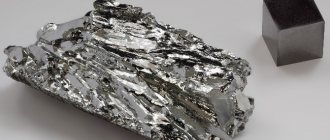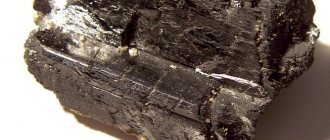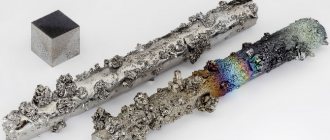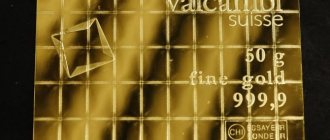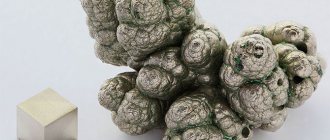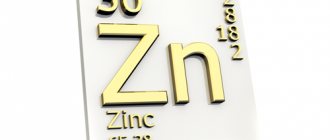| 42 | Molybdenum |
| Mo 95,95 | |
| 4d55s1 | |
Molybdenum
- an element of the sixth group (according to the old classification - a secondary subgroup of the sixth group) of the fifth period of the periodic system of chemical elements of D.I. Mendeleev, atomic number 42. Denoted by the symbol
Mo
(lat. Molybdaenum).
The simple substance molybdenum
is a light gray transition metal. Its main application is in metallurgy.
Content
- 1 History and origin of the name
- 2 Occurrence in nature 2.1 Deposits
- 2.2 In space
- 3.1 Genetic groups and industrial types of deposits
- 5.1 Isotopes
- 8.1 Nitrogen cycle
Daily requirement
It is not precisely defined, and the figures given are largely advisory in nature.
| Category | Daily value, mcg |
| Infants under 2 years old | 5-6 |
| Children 3-5 years old | 8-10 |
| Children 6-8 years old | 10-20 |
| Children 9-13 years old | 20-30 |
| Teenage boys | 50-60 |
| Teenage girls | 40-50 |
| Adult men | 70-80 |
| Adult women | 70 |
| Pregnant | 80 |
In case of severe illness or physical activity, the need for Mo may increase to 100 mcg. Some believe that in extreme situations, in pathological conditions, molybdenum is needed even more - up to 300-400 mcg/day.
History and origin of the name
It was discovered in 1778 by the Swedish chemist Carl Scheele, who obtained MoO3 by calcining molybdic acid. It was first obtained in the metallic state by P. Ghelm in 1781 by reducing the oxide with coal: he obtained molybdenum contaminated with carbon and molybdenum carbide. Pure molybdenum was obtained in 1817 by J. Berzelius by reducing the oxide with hydrogen.
The name comes from ancient Greek. μόλυβδος, meaning "lead". It is given because of the external similarity of molybdenite (MoS2), the mineral from which molybdenum oxide was first isolated, with lead luster (PbS). Until the 18th century, molybdenite was not distinguished from graphite because of its lead-like luster; these minerals bore the common name “molybdenum.”
Synthetic analogues
It is not produced in the form of pharmaceuticals. But it is present in numerous dietary supplements and multivitamin complexes (MultiMax, Alphabet, Duovit, Centrum, Vitrum, etc.).
These drugs are used as general strengthening, immunostimulating agents, as a prophylaxis and auxiliary treatment of diseases of the gastrointestinal tract, heart, blood vessels, kidneys, nervous and reproductive systems.
Another drug, Molybdenum 99, is used in medicine, but not for medicinal, but for diagnostic purposes. To diagnose a heart attack, tumor processes, and a number of other diseases, radioisotope scanning is used.
Healthy and diseased organs absorb radioisotopes differently, and these changes are clearly visible in a special device, a gamma camera.
Technetium 99 is used as a radioisotope. And the raw material for its production is another radioisotope, Molybdenum 99, 99Mo. It differs from stable molybdenum, 98Mo, 99Mo by the “extra” neutron in the atomic nucleus. 99Mo is produced during nuclear reactions from uranium or its stable variant.
Being in nature
The content in the earth's crust is 3⋅10−4% by weight. Molybdenum is not found in free form. In the earth's crust, molybdenum is distributed relatively evenly. Ultramafic and carbonate rocks contain the least amount of molybdenum (0.4–0.5 g/t). The concentration of molybdenum in rocks increases as SiO2 increases. Molybdenum is also found in sea and river water, in plant ash, in coal and oil. The content of molybdenum in seawater ranges from 8.9 to 12.2 μg/l for different oceans and water areas. What is common is that waters near the shore and the upper layers are less enriched in molybdenum than waters at depth and away from the shore. The highest concentrations of molybdenum in rocks are associated with accessory minerals (magnetite, ilmenite, sphene), but the bulk of it is contained in feldspars and less in quartz. Molybdenum in rocks is found in the following forms: molybdate and sulfide in the form of microscopic and submicroscopic precipitation, isomorphic and dispersed (in rock-forming minerals). Molybdenum has a greater affinity for sulfur than for oxygen, and tetravalent molybdenum sulfide, molybdenite, is formed in ore bodies. A reducing environment and high acidity are most favorable for the crystallization of molybdenite. Under surface conditions, predominantly oxygen compounds MO6+ are formed. In primary ores, molybdenite is found in association with wolframite and bismuthin, with copper minerals (porphyry copper ores), as well as with galena, sphalerite and uranium pitch (in low-temperature hydrothermal deposits). Although molybdenite is considered a stable sulfide with respect to acidic and alkaline solvents, under natural conditions, with prolonged exposure to water and atmospheric oxygen, molybdenite is oxidized, and molybdenum can migrate intensively to form secondary minerals. This can explain the increased concentrations of molybdenum in sedimentary deposits - carbonaceous and siliceous-carbonaceous shales and coals.
About 20 molybdenum minerals are known. The most important of them are: molybdenite MoS2 (60% Mo), powellite CaMoO4 (48% Mo), molybdite Fe(MoO4)3 nH2O (60% Mo) and wulfenite PbMoO4.
Place of Birth
Large deposits of molybdenum are known in the USA, Mexico, Chile, Canada, Australia, Norway, and Russia. In Russia, molybdenum is produced at the Sorsk ferromolybdenum plant. More than 7% of the world's molybdenum reserves are located in Armenia, with 90% of them concentrated in the Kajaran copper-molybdenum deposit.
In space
An abnormally high molybdenum content is observed in stellar formations consisting of a red giant (or supergiant) with a neutron star inside—Landau-Thorn-Zhitkova objects.
Molybdenum Processing
Processing of molybdenum is difficult due to its low viscosity at low temperatures. It also has low ductility, so the following methods are used for its processing:
- hot deformation:
- forging;
- rolling;
- broach;
- heat treatment;
- mechanical restoration.
When processing small workpieces, crimping machines are used. Large billets are rolled on small mills or shaped on broaching machines.
Appearance of molybdenum
If there is a need for machining by cutting, then machining of molybdenum is carried out with a tool made from high-speed steel grades. The sharpening of tool corners during turning should correspond to the sharpening angles for machining cast iron.
The heat treatment of molybdenum is characterized by high hardenability due to its content in steels. The hardening carried out increases the hardness and wear resistance of critical parts.
Production
Molybdenum deposits and its production by country
| A country | Deposits (thousand tons) | 2001 | 2002 | 2003 | 2004 | 2005 | 2006 | 2007 | 2014 |
| USA | 2700 | 37,6 | 32,3 | 29,9 | 41,5 | 58,0 | 59,8 | 59,4 | 68,2 |
| China | 3000 | 28,2 | 30,33 | 32,22 | 29,0 | 40,0 | 43,94 | 46,0 | 103,0 |
| Chile | 1905 | 33,5 | 29,5 | 33,4 | 41,48 | 47,75 | 43,28 | 41,1 | 48,8 |
| Peru | 850 | 8,35 | 8,32 | 9,63 | 9,6 | 17,32 | 17,21 | 17,25 | 17,0 |
| Canada | 95 | 8,56 | 7,95 | 8,89 | 5,7 | 7,91 | 7,27 | 8,0 | 9,7 |
| Russia | 360 | 3,93 | 4,29 | 3,57 | 3,11 | 3,84 | 3,94 | 4,16 | 4,8 |
| Mexico | 135 | 5,52 | 3,43 | 3,52 | 3,7 | 4,25 | 2,52 | 4,0 | 14,4 |
| Armenia | 635 | 3,4 | 3,6 | 3,5 | 3,0 | 2,75 | 3,0 | 3,0 | 7,1 |
| Iran | 120 | 2,6 | 2,4 | 2,4 | 1,5 | 2,0 | 2,0 | 2,5 | 4,0 |
| Mongolia | 294 | 1,42 | 1,59 | 1,6 | 1,7 | 1,19 | 1,2 | 1,5 | 2,0 |
| Uzbekistan | 203 | 0,58 | 0,5 | 0,5 | 0,5 | 0,57 | 0,6 | 0,5 | 0,5 |
| Bulgaria | 10 | 0,4 | 0,4 | 0,2 | 0,2 | 0,2 | 0,4 | 0,4 | ? |
| Kazakhstan | 130 | 0,09 | 0,05 | 0,05 | 0,23 | 0,23 | 0,25 | 0,4 | — |
| Kyrgyzstan | 100 | 0,25 | 0,25 | 0,25 | 0,25 | 0,25 | 0,25 | 0,25 | ? |
| Others | 1002 | — | — | — | — | — | — | — | — |
| Total | 11539 | 134,4 | 124,91 | 129,63 | 141,47 | 186,26 | 185,66 | 188,71 |
Genetic groups and industrial types of deposits
1. Contact-metasomatic (skarns).
2. Hydrothermal.
A. High temperature (greisen). B. Medium temperature. A. quartz-molybdenite. b. quartz-sphalerite-galena-molybdenite. V. quartz-chalcopyrite-molybdenite (porphyry copper ores). pitchblende-molybdenite.
World reserves
Global identified molybdenum resources present in the subsoil of 35 countries are estimated at 11.54 million tons (forecast - 22.62 million tons). The largest proven reserves, according to the US Geological Survey, are:
- China – 3 million tons.
- USA – 2.7 million tons.
- Chile – 1.905 million tons.
- Canada – 0.95 million tons.
- Peru – 0.85 million tons.
- Armenia – 0.635 million tons.
- Argentina – 0.372 million tons.
- Mongolia – 0.294 million tons.
- Colombia – 0.277 million tons.
- Russia – 0.24 million tons.
- Panama – 0.227 million tons.
- Uzbekistan – 0.203 million tons.
- Mexico – 0.135 million tons.
- Kazakhstan – 0.13 million tons.
- Iran – 0.12 million tons.
- Kyrgyzstan – 0.1 million tons.
- Papua New Guinea – 0.099 million tons.
Physical properties
Molybdenum is a light gray metal with a body-centered cubic lattice of the α-Fe type ( a
= 3.14 Å;
z
= 2;
space group Im3m
), paramagnetic, the Mohs scale defines its hardness as 4.5 points. Mechanical properties, as with most metals, are determined by the purity of the metal and previous mechanical and thermal treatment (the purer the metal, the softer it is). Has an extremely low coefficient of thermal expansion. Molybdenum is a refractory metal with a melting point of 2620 °C and a boiling point of 4639 °C.
Isotopes
Main article: Isotopes of molybdenum
Natural molybdenum consists of seven isotopes: 92Mo (15.86% by weight), 94Mo (9.12%), 95Mo (15.70%), 96Mo (16.50%), 97Mo (9.45%), 98Mo (23.75%) and 100Mo (9.62%). Six of them are stable, 100Mo is weakly radioactive (half-life 8.5⋅1018 years, which is a billion times greater than the age of the Universe). Of the artificial isotopes, the most stable is 93Mo, with a half-life of 4 thousand years; the half-life of other isotopes does not exceed 3 days.
Advantages/disadvantages
- Advantages:
- has a high melting point, and therefore heat resistance;
- because the density of this metal (10200 kg/m3) is almost two times less than the density of tungsten (19300 kg/m3), then molybdenum-based alloys have significantly greater specific strength (at temperatures below 1370 °C);
- has a high elastic modulus;
- low temperature coefficient of expansion;
- has good heat resistance;
- small cross section for thermal neutron capture;
- Molybdenum is characterized by high corrosion resistance. This metal is stable in most alkaline solutions, as well as in sulfuric, hydrochloric and hydrofluoric acids at different temperatures and concentrations.
- Flaws:
- has little scale;
- high fragility of welds;
- low plasticity at low temperatures;
- work hardening can be used only up to 700-800 °C; at higher temperatures, softening occurs due to return.
Chemical properties
At room temperature in air, molybdenum is stable. Begins to oxidize at 400 °C. Above 600 °C it quickly oxidizes to MoO3 trioxide. This oxide is also obtained by the oxidation of molybdenum disulfide MoS2 and the thermolysis of ammonium molybdate (NH4)6Mo7O24·4H2O.
Mo forms molybdenum(IV) oxide MoO2 and a number of oxides intermediate between MoO3 and MoO2.
Mo forms a number of compounds with halogens in different oxidation states. When molybdenum powder or MoO3 reacts with F2, molybdenum hexafluoride MoF6, a colorless, low-boiling liquid, is obtained. Mo (+4 and +5) forms solid halides MoHal4 and MoHal5 (Hal = F, Cl, Br). Only molybdenum diiodide MoI2 is known with iodine. Molybdenum forms oxyhalides: MoOF4, MoOCl4, MoO2F2, MoO2Cl2, MoO2Br2, MoOBr3 and others.
When molybdenum is heated with sulfur, molybdenum disulfide MoS2 is formed, and with selenium, molybdenum diselenide of the composition MoSe2 is formed. The known molybdenum carbides Mo2C and MoC are crystalline high-melting substances and molybdenum silicide MoSi2.
A special group of molybdenum compounds is molybdenum blues. When reducing agents - sulfur dioxide, zinc dust, aluminum or others - act on weakly acidic (pH=4) suspensions of molybdenum oxide, bright blue substances of variable composition are formed: Mo2O5·H2O, Mo4O11·H2O and Mo8O23·8H2O.
Mo forms molybdates, salts of weak molybdic acids not isolated in the free state, xH2O MoO3 (ammonium paramolybdate 3(NH4)2O 7MoO3 zH2O; CaMoO4, Fe2(MoO4)3 - found in nature). Molybdates of metals of groups I and III contain tetrahedral groups [MoO4].
When aqueous solutions of normal molybdates are acidified, MoO3OH− ions are formed, then polymolybdate ions: hepta-, (para-) Mo7O266−, tetra-(meta-) Mo4O132−, octa-Mo8O264− and others. Anhydrous polymolybdates are synthesized by sintering MoO3 with metal oxides.
There are double molybdates, which contain two cations at once, for example, M+1M+3(MoO4)2, M+15M+3(MoO4)4. Oxide compounds containing molybdenum in lower oxidation states are molybdenum bronzes, for example, red K0.26MoO3 and blue K0.28MoO3. These compounds have metallic conductivity and semiconductor properties.
Metabolism
Once taken orally, it is absorbed in the stomach and in the initial parts of the small intestine. Depending on the food source, absorption ranges from 25-80%, but can approach 100%. The microelement that enters the blood is partially present in the formed elements, and partially in the plasma, in combination with plasma proteins albumin.
Together with albumin, it is distributed to organs and tissues. Its distribution in the body is uneven. There is relatively a lot of Mo in the skin and bone tissue, as well as in internal organs, mainly in the liver and kidneys. It is excreted by these same organs, the kidneys and liver, in urine and bile. At the same time, it does not accumulate in the body.
Application
Molybdenum is used to alloy steels as a component of heat-resistant and corrosion-resistant alloys. Molybdenum wire (tape) is used for the manufacture of high-temperature furnaces and electric current inputs in incandescent lamps. Molybdenum compounds - sulfide, oxides, molybdates - are catalysts for chemical reactions, pigments for dyes, and components of glazes. Molybdenum hexafluoride is used when applying metal Mo to various materials, MoS2 is used as a solid high-temperature lubricant. Mo is included in microfertilizers. Radioactive isotopes 93Mo ( T
1/2 = 6.95 h) and 99Mo (
T
1/2 = 66 h) are isotopic indicators.
Molybdenum is one of the few alloying elements that can simultaneously increase the strength, toughness properties of steel and corrosion resistance. Usually, when alloying, along with an increase in hardness, the fragility of the metal also increases. There are known cases of molybdenum being used in the manufacture of edged weapons in Japan in the 11th-13th centuries.
Molybdenum-99 is used to produce technetium-99, which is used in medicine in the diagnosis of cancer and some other diseases. The total world production of molybdenum-99 is about 12,000 curies per week (based on activity on the sixth day), the cost of molybdenum-99 is $46 million per gram ($470 per 1 Ci).
In 2005, world supplies of molybdenum (in terms of pure molybdenum) amounted, according to Sojitz Alloy Division, to 172.2 thousand tons (in 2003 - 144.2 thousand tons). Pure single-crystal molybdenum is used to produce mirrors for high-power gas-dynamic lasers. Molybdenum telluride is a very good thermoelectric material for the production of thermoelectric generators (thermo-emf 780 µV/K). Molybdenum trioxide (molybdenum anhydride) is widely used as a positive electrode in lithium power sources.
Molybdenum is used in high-temperature vacuum resistance furnaces as heating elements and thermal insulation. Molybdenum disilicide is used as heaters in furnaces with an oxidizing atmosphere operating up to 1800 °C.
Hook-holders for the filament body of incandescent lamps, including general-purpose incandescent lamps, are made from molybdenum.
Molybdenum wire with a diameter of 0.05-0.2 mm is used in wire EDM machines for cutting metals with very high accuracy (up to 0.01 mm), including workpieces of large thickness (up to 500 mm). Unlike copper and brass wire, which are used once in such machines, molybdenum wire is reusable (~300-500 meters is enough for 30-80 hours of continuous operation), which somewhat reduces the accuracy of processing, but increases its speed and reduces its cost.
Heat-resistant alloys
The technology of ultra-high-speed and space flights poses the task of metallurgists to obtain increasingly heat-resistant materials. Strength at high temperatures depends primarily on the type of crystal lattice and, of course, on the chemical nature of the material. The operating temperature limit for titanium alloys is 550-600° C, molybdenum alloys - 860, and titanium-molybdenum alloys - 1500° C!
How can we explain such a significant jump? Its reason is in the structure of the crystal lattice. Foreign atoms are introduced into the body-centered structure of molybdenum, this time titanium atoms. The result is a so-called interstitial solid solution, the structure of which can be represented as follows. Atoms of molybdenum, the base metal, are located at the corners of the cube, and atoms of the added metal, titanium, are located in the centers of these cubes. Instead of a body-centered crystal lattice, a face-centered one appears, in which the processes of softening under the influence of temperatures occur much less rapidly.
This purposeful change in the crystal structure of metals is one of the basic principles of alloying.
Another reason for such a sharp increase in heat resistance lies in the fact that very dissimilar metals are fused - molybdenum and titanium. This is a general rule: the greater the difference between the atoms of the alloying metal and the base metal, the stronger the bonds formed. The metallic bond is, as it were, complemented by the chemical one.
Alloying, however, is not the last word in solving the problem of heat-resistant alloys. Already in our time, the extraordinary properties of threadlike crystals, or “whiskers,” have been discovered. Their strength, compared to metals commonly used in technology, is amazingly high. This is explained by the fact that the crystalline structure of the whiskers is practically free of defects, and the technology of ultra-high-speed flights takes the whiskers into service, creating composite heat-resistant materials with their help. One of these materials is aluminum oxide reinforced with molybdenum whiskers, the other is technical titanium stuffed with the same reinforcement. Compared to conventional titanium, this material can last 1000 times longer under harsh conditions.
What can be opposed to a fiery tornado that hits a spaceship upon entering the dense layers of the atmosphere? First of all, heat-protective coating and cooling. Yes, cooling, similar in principle to cooling car engines using radiators. Only more energy-intensive processes must work here. A lot of heat is needed to evaporate substances, but even more for sublimation - transfer from a solid state directly to a gaseous state. At high temperatures, molybdenum, tungsten, and gold can sublimate. Coating the bow of the ship with molybdenum or other of the listed (more expensive) metals will significantly weaken the force of the firestorm through which the spacecraft's return vehicle must pass.
Other industries
The lion's share of products made from molybdenum and metal alloys is taken by manufacturers of radio and electric lamps, radio electronics.
There is enough material for other purposes:
- Molds, machine parts for injection molding of alloys.
- Electrovacuum production (X-ray tubes).
- Positive electrode of lithium-based current sources.
- Shells of nuclear reactor parts.
- Heaters for electric furnaces operating in harsh conditions.
- The outer layer of the “nose” segment of the body of supersonic aircraft.
- Electrodes for glass melting.
- Catalysis of chemical reactions.
- Varnishes, paints for porcelain, textiles, furs.
These products are created on the basis of natural compounds and metal alloys.
The newest area of application of molybdenum is space technology.
Assortment: components of rocket (ion, plasma) engines; skin of descent vehicles; heat exchangers. Here, the properties of molybdenum are corrected by alloys with niobium and tantalum.
Pure crystalline Mo is used as a component of mirrors for special purpose lasers.
Microdoses of metal are added to agricultural fertilizers.
Biological role
The physiological significance of molybdenum for the animal and human body was first demonstrated in 1953, with the discovery of the influence of this element on the activity of the enzyme xanthine oxidase. Molybdenum promotes (makes it more effective) the work of antioxidants, including vitamin C. An important component of the tissue respiration system. Strengthens the synthesis of amino acids, improves nitrogen accumulation. Molybdenum is part of a number of enzymes (aldehyde oxidase, sulfite oxidase, xanthine oxidase, etc.) that perform important physiological functions, in particular, the regulation of uric acid metabolism. Molybdenum enzymes catalyze the hydroxylation of various substrates. Aldehyde oxidase oxidizes and neutralizes various pyrimidines, purines, and pteridines. Xanthine oxidase catalyzes the conversion of hypoxanthines to xanthines, and xanthines to uric acid. Sulfite oxidase catalyzes the conversion of sulfite to sulfate.
A lack of molybdenum in the body is accompanied by a decrease in the content of xanthine oxidase in tissues. With a lack of molybdenum, anabolic processes suffer, and a weakening of the immune system is observed. Ammonium thiomolybdate (soluble molybdenum salt) is a copper antagonist and disrupts its utilization in the body.
Nitrogen cycle
Molybdenum is part of the active site of nitrogenase, an enzyme for fixing atmospheric nitrogen (common in bacteria and archaea).
Microelement
Micro amounts of molybdenum are necessary for the normal development of organisms; it is used as part of microelement nutrition, in particular, for berry crops.
Affects reproduction (in plants).
Sources of income
During the day, with a balanced diet, an adult receives from 75 to 250 mcg of Mo. This amount generally covers the daily requirement for the microelement.
Mostly found in protein foods. This is not only meat, but also fish, but also meat by-products (liver, heart, kidneys, brain). Plant proteins included in grains and legumes also contain large amounts of it.
Mo content in 100 g of food products:
| Product | Content, µg/100 g |
| Beef | 10 |
| Beef liver | 110 |
| Beef kidneys | 87 |
| Beef heart, brains | 18 |
| Pork | 12 |
| Pork liver | 81 |
| Pork kidneys | 43 |
| Pig heart | 19 |
| Chicken | 16 |
| Chicken liver | 55 |
| Chicken eggs | 41 |
| Turkey | 28 |
| Soybeans | 95 |
| Peas | 83 |
| Lentils | 76 |
| Beans | 39 |
| Cocoa beans | 41 |
| Oat groats | 38 |
| Buckwheat | 35 |
| Rice | 25 |
| Wheat grain | 42 |
| Milk | 35 |
| Cod | 13 |
| Horse mackerel | 26 |
| Squid | 20 |
| Sprats in oil | 11 |
| Pasta | 11 |
| Black currant | 24 |
| Raspberries | 14 |
| Gooseberry | 11 |
| Green onions | 19 |
It is lost during prolonged cooking of food. The same goes for freezing meat, offal and fish.
Precautionary measures
Regarding possible drug interactions, high doses have been found to inhibit the metabolism of acetaminophen in rats, so taking acetaminophen with this element is not recommended (4).
People who are deficient in dietary copper or have disorders of copper metabolism that lead to their copper deficiency may be at increased risk of developing molybdenum toxicity.
You should not take this trace mineral supplement if you have gallstones or kidney problems.
If you are pregnant or breastfeeding, have a medical condition, or are currently taking medications, always talk to your doctor before taking any new supplement.
Final Thoughts
- Molybdenum is necessary for the body to include the breakdown of macronutrients, enzyme-dependent processes, iron metabolism and detoxification from harmful substances.
- The benefits of molybdenum may include preventing or improving some health problems, but to date there has been limited research to definitively support the need for supplementation, especially when deficiency is so rare.
- One example of a condition that it may help is esophageal cancer, as studies have shown that its deficiency may play a role in the higher incidence of esophageal cancer in populations consuming food grown in soil low in this mineral.
- Healthy foods that contain this element include lentils, dried peas, black beans, oats and romaine lettuce.
- The best and safest way to obtain this micronutrient is through diet, especially since deficiency is extremely rare.
- Excessive amounts of this trace mineral through supplements (or industrial exposure) can cause gout and/or copper deficiency.
